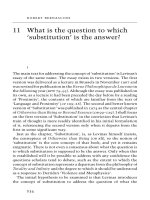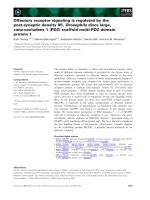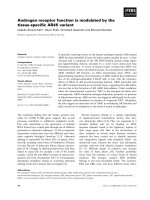What is meant by the case
Bạn đang xem bản rút gọn của tài liệu. Xem và tải ngay bản đầy đủ của tài liệu tại đây (10.7 KB, 2 trang )
What is meant by the case?
Case
shows how a noun or a pronoun is related to another word in a sentence. A noun or pronoun can be in the
following cases:
1) Nominative case
2) Objective (or accusative) case
3) Dative case
4) Vocative case
5) Case in apposition
6) Possessive case
Nominative and Objective Case
Study the example given below.
The cat drank the milk.
Here the noun ‘cat’ is the subject of the verb ‘drank’. When a noun or a pronoun is used as the subject of a
verb, it is said to be in the nominative case.
Now read the sentence given below.
The boy killed the spider.
Here the noun ‘the spider’ is the object of the verb ‘killed’. When a noun or pronoun is used as the object of a
verb, it is said to be in the objective case. A noun which comes after a preposition is also said to be in the
objective case. In this case, the noun acts as the object of the preposition.
She sat between
them.
(Here the pronoun them is the object of the preposition between. It is therefore in the objective case.)
Dative and Vocative Case
Some verbs take two objects: a
direct object
and an
indirect object.
I bought him a dress.
Here the pronoun ‘him’ is the indirect object of the verb ‘bought’ whereas the noun ‘dress’ is the direct object.
A noun used as the direct object of the verb is said to be in the
objective case
, whereas a noun used as the
indirect object of the verb is said to be in the
dative case.
Vocative case
Read the following sentences.
Peter, sit down.
Here the noun Peter is used for addressing a person or thing. A noun used to address a person or thing is said to
be in the vocative case.
Be first to know when grammar rules change! Sign up to our newsletter here: englishgrammar.org (It's free)
Powered by TCPDF (www.tcpdf.org)









